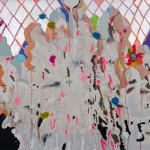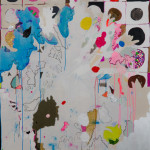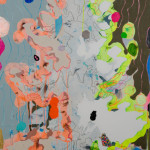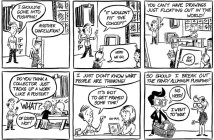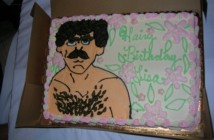LAUREL SPARKS: PLEASURE DOME @ HOWARD YEZERSKI
The studied madness suffusing the paintings in “Pleasure Dome,” Laurel Sparks’s new show at the Howard Yezerski Gallery, was clearly a labor of love. Dystopian and engag-ing, the works exhibit multiple levels of dynamism and a commitment to craftspersonship that make admiring them a rewarding experience. Color and line twist and spar in deca-dent, convoluted layers that constitute an edgy funhouse, fascinating the eye with neons, sparkle paint and other fabulous media. Neither pretty nor grotesque, they are deep and distinctive works, at once abstract and approachable. With its energetic, chock-full aes-thetic, “Pleasure Dome” offers the viewer access to a glamorous, decaying otherworld that resides far enough across the boundary between life and art to make the visit more than worthwhile.
The paintings vaguely resemble bouquets, fountains or eruptions through skeletons of gray acrylic on bare canvas piled high with powerful, dashing colors. In fact, various chandeliers comprise the base images for the works in “Pleasure Dome,” as they have for some of Sparks’ other series. In the painting “Candy Castle,” for example, the ever-present gray acrylic line loops about in intense, baroque gestures, implying a barely-discernable chandelier shape. This line isn’t crisp or clean or continuous, and doesn’t compete for attention with the cotton-candy pink and blue that swirl and squirm along the perimeter of the Christmas-tree-like form it delineates. At the same time, dark nebulae of pure pigment dust punctuate the canvas as environmental pockets of yellow, red, black and brown create a Spartan but sumptuous, almost Klimtian, color field. Meanwhile, blobs of papier-mâché protrude from the canvas, supporting clusters of synthetic multico-lored craft-store puffballs and chunks of colored plastic. These adornments contrast with craggy bulges made of raw pigment mixed with marble dust. One such bulge is bright red-orange and lies in a pink acrylic field that laps at and covers its edges, suggesting a lanced boil or magnified skin inflammation. The cumulative effect of these diverse com-ponents is an intense and layered dynamism, leaving the surface of “Candy Castle” over-flowing but not overdone.
The relationship between line and color constitute the principal drama of “Pleasure Dome.” Some version of a call-and-response format is typical; the line and the colors need one another, but color invariably steals the show. In, for example, “Vanitas,” a multitude of colored patches perform most of the work, sloppily reproducing and almost entirely obscuring the chandelier shape described by the gray line. The dynamic here seems dissonant, almost antagonistic, as though the gray is a signpost attempting to convey meaning and the color is the graffiti that confuses it while enhancing it, with the resulting canvas visually piecemeal but thematically unified. In “Arcadia,” on the other hand, color has run wild, painting over, rather than around or along, the image of the chandelier, yet a stately bulge of olive pigment and marble dust in a field of mauve occupying the painting’s upper right quadrant offers a beautiful counterpoint to the mad, dripping colo-ration below. On the other side of the spectrum is “Archangel,” my favorite piece in the show, which features far more disegno than colore. In some ways a mi-niature-scale version of the more opulent works, the surface of “Archangel” is busy, brimming with hundreds of little dramas, almost like a Bosch or Brueghel. In general, it must be said that Sparks chooses colors that are powerful and difficult to control, and controls them.
The background image of the chandelier, while inconstant and pale, generally observes y-axis symmetry, which lends some of the works the flavor of a painted-over Rorschach. Read in this way, the surfaces’ myriad colors and textures constitute the artist’s response to the “prompt” of the original image, the chandelier. As this symbol of opulence has re-sulted in artistic effusion, the question then becomes whether the paintings of “Pleasure Dome” are works of celebration, satire or elegy. In fact, it contains elements of each. Whereas neon yellows and parking-cone oranges imply vigor, drips and vertical streaks of color, present in almost every piece, connote decline. And then there’s Sparks’s use of sparkle paint. While these swathes of iridescence confirm the gallery’s assertion that these paintings “love the light,” the sparkles, like the synthetic puff-balls, reference the art-making of childhood, when such implements were valued for their visual or tactile “prettiness.” At the same time, however, there is no reason to believe that the artist is at-tempting to deconstruct anything through their inclusion; rather, in light of the confident, flexible aesthetic of the pieces overall, these alternative media seem self-deprecating and fun. They exist here to add some texture, some lightness, and there’s nothing wrong with a surprise, after all.
The show takes its name from “Inauguration of the Pleasure Dome,” a 1954 film by expe-rimental filmmaker Kenneth Anger. Although similarities exist between the two, unlike Sparks, Anger thematizes decadence through grotesquery – for example, his characters eat and feed one another pieces of jewelry – and his film is ultimately hellish and dark. In contrast, the paintings of “Pleasure Dome,” successfully maintain depth of feeling while preserving attractiveness of form. With its intuitive beauty and passionate palette, the show has far more in common with “Kubla Khan,” the Samuel Taylor Coleridge poem that mentions a “stately pleasure-dome,” the inspiration for the title of Anger’s film.
The show is highly successful overall, with much to praise and admire. My sole critique is that the bare canvas forming the core of most pieces in the show does not mesh well with the blank walls of the gallery; I left convinced that they would look much better, for instance, hanging on my wall at home.
- Laurel Sparks, Archangel, Acrylic, silver enamel, marble dust, glitter, paper mache, small objects, feathers, marker, pigment, unpainted canvas, 2008.
- Laurel Sparks, Genesis, Acrylic, silver enamel, marble dust, glitter, confetti, paper mache, small objects, marker, pigment, unpainted canvas, 2008.
- Laurel Sparks, Christmas in July, Acrylic, marble dust, glitter, paper mache, small objects, marker, pigment, unpainted canvas, 2008.
"Laurel Sparks: Pleasure Dome" is on view February 6 - March 10, 2009 at Howard Yezerski Gallery.
All images are courtesy of the artist and Howard Yezerski Gallery.


